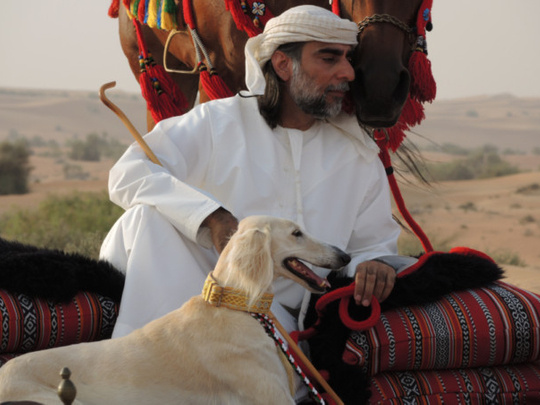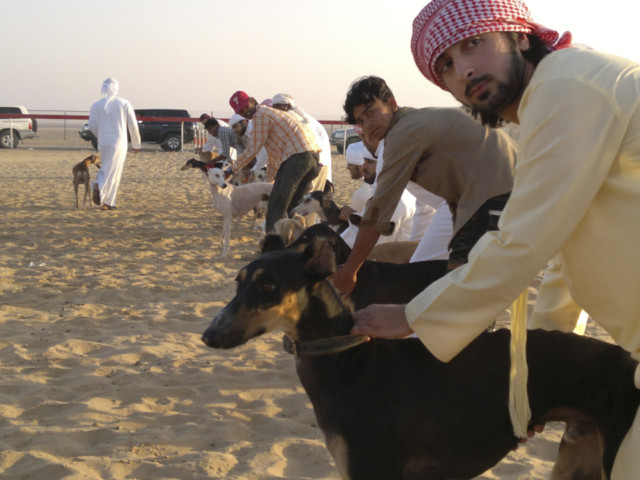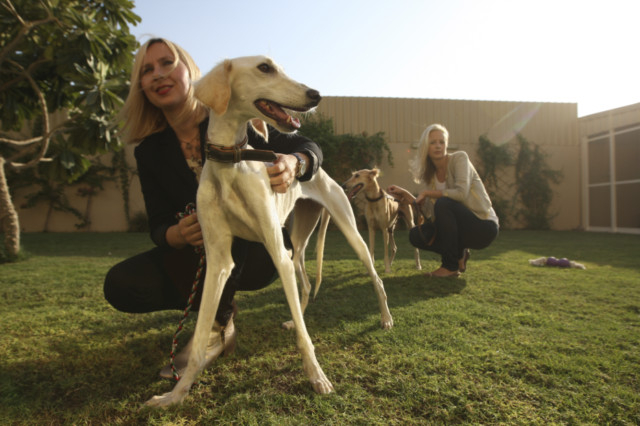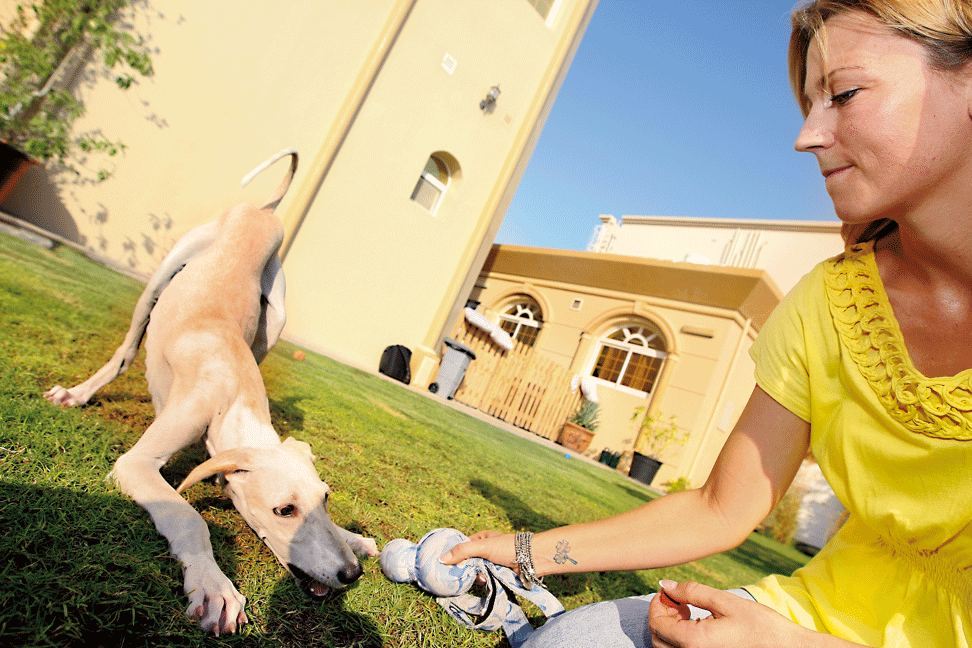
Thirteen centuries ago, the saluki inspired the Bedouins to such poetry that they called it a wind drinker, gazelle hound, daughter of the tent and desert eye. Ancient poetry describes salukis having “the head of a snake, the neck of a drake, a back like a beam, a side like a bream, the tail of a rat and the foot of a cat”. Humans who come into contact with salukis today are no less moved.
Hamad Ghanem Shaheen Al Ghanem pictured left), Breeder, Registrar General and Director of the Saluki of Arabia Club, will tell you that if your salukis sense that you don’t want them, they will go away. “Salukis need people and families. When they don’t feel wanted, they leave,” he says.
Shaikh Rashid Bin Ahmad Al Maktoum, who with partner Ali Rashid Al Kaabi, owns about 100 race salukis, says that salukis don’t smell. “They are clean and don’t drool like dogs. They are playful. The problem is that if it loves you, it will die for you,” he says.
Yelena Y. Swain and Trine Lund Petersen, who run the rescue centre Arabian Saluki Center of Dubai, insist that salukis are elegant. “They are so regal and noble. I would always be confident to come to any saluki no matter how scared and stressed it is because I know it will never charge at me,” says Swain, as Lund Petersen adds they are dear to her. “To see a dog have a job [to hunt] and do it and come home and be a family dog, to me that is something,” she says.
The word dog features very seldom in a conversation about these sight hounds, bred to pursue game by sight rather than smell. “They are not dogs. They are salukis” is an often heard indignant response from many owners if the word does come up.
Expert opinion is that salukis are all that their fond owners say they are. Dog behaviour expert Verity Rosewarne says, “Salukis don’t tend to be barkers. They are laid-back and relaxed, but at the same time, and it is almost a contradiction in terms, they can be high-energy dogs. They are hounds. They don’t like being left to their own devices. If they are, they can be anxious, nervous, bored and lonely.”
To those expecting a bloodthirsty beast, they show their playfulness, tugging at the leash wanting to go out and play. At a racing event with live prey such as a gazelle, it’s possible to spot a saluki chasing with all its might to take it down, only to wait for the master to arrive rather than indulging in the kill.
As any owner will tell you, they are rather independent and not given to structure. “They are so intent on hunting and play, it can detract from other areas that you work on,” says Rosewarne.
The breeder
Hamad Ghanem Shaheen Al Ghanem is comfortable with the fact that the existence of salukis in his house predate him. “It was not that I was a child and I asked for one. They were there before me. As our families grew, they were breeding as well,” he says, thinking aloud seated in a sheesha lounge in a Dubai five-star, his falcon Sarab perched on a chair cleaning a bone of last bits of flesh.
“We did not have television and PlayStations. We focused on life. Salukis were not a hobby. If you asked me then what my hobby was, I would’ve said school. Because that was new,” he says, watching Sarab for signs to see if she is done with her meal. Minutes later, she drops the bone and he is up immediately, ready with the hood so she can settle on the table as the conversation continues.
“Hobby is something that you choose. I did not choose these animals. They were there,” he says, concluding that they are probably closer to being a passion than anything else.
Al Ghanem is a familiar name when it comes to the preservation of animals associated with traditional life in the UAE. He has been involved in the creation of the national archive for camels and horses. Al Ghanem is also the subject of a book, Hamad The Young Falconer by Randa Hamwi Duwaji, on his childhood spent with falcons. Writing a book on salukis, collecting information on it along with photographs, old poetry, is all a vocation, as is creating a DNA database for the saluki of Arabia.
“It’s not about finding out who is the father or the mother, brother or sister of one line. With the database, if you find a saluki you would know which line it comes from — Yemen, Syria or Iraq. We have now collected more than 140 samples. We are looking at 800 to generate the database,” he says.
Long before saluki owners enjoyed government support as they do today, Al Ghanem had been breeding salukis and involved with keeping the breed pure, with a stud book that boasts about 1,800 dogs. A well-kept saluki, he says, can easily live up to 23 years.
“I started the stud book in 1979 or 1980. It came about because I needed to know where my dogs were going. I started writing down that information — descriptions, owner’s name and country. Then I did not call it a stud book, it was a ledger to write about my stock, its types, colours and whether it was male or female,” he says.
As a breeder with salukis sent all over the world — England, Spain, Italy, France, Australia, the US, Canada, Finland, Austria and Switzerland — Al Ghanem is associated with saluki clubs all over the world and is the founder of the Saluki of Arabia Club. At home in the UAE, he is passionate about ensuring that salukis capture the interest of the young generation in a way that suits their life.
“I organise hunting, a beauty contest and dog shows. I do seminars in colleges and schools, talking about salukis and falcons and our heritage. And we do a lot of documentary films and articles in English and Arabic,” he says. He is planning a workshop at the Canadian University of Dubai.
Races organised every December for the past six years now bring in at least 300-400 pure-bred salukis and beauty contests allow owners to proudly show their feathered or smooth beauties.
“There is a question that if we don’t need to hunt why do we keep it?” he asks, answering immediately, “If our old salukis could talk about our ancestors, they would talk. We look at their eyes and we respect them. It’s like saying if you take the metro or a cab and don’t need to drive a car, you do not need a licence. But you need it. One day if nothing works, you need to depend on yourself.”
The racer
Despite the hour and a half that it takes to drive from Dubai to Sweihan camel racetrack, Shaikh Rashid Bin Ahmad Al Maktoum’s ten or so young salukis that he wants to train today are already there when the full moon is still appliquéd on a dark sky at about 5am.
They scramble out one after the other from the car, minders quickly collaring them — one handler for two salukis, one dog at each end of the leash. Once, his saluki, Shaikh Rashid says, decided to squat smack bang in the middle of the racetrack to relieve itself, as its mates ran past chasing the target.
“That was a lesson. Now I make sure they’ve been walked an hour before,” he says, taking his fastest runner today under his care, even as he points to dog-shaped constellations in the clear desert sky.
As it gets lighter, the moon still visible on the fading background, other 4X4s start coming in with their saluki passengers. By the time the sun makes its appearance on the horizon, about four to five dogs are secured on the tiny poles, checking out the human scramble, straining to be a part of the action. While the others, not part of the first round, wait in the air-conditioned cars.
“This is kind of new, only going on for a couple of years. Earlier, we did not race our dogs. We, as a people, used to have dogs. We used to have camels and horses. But these were only for hunting. Now, the sport has really grown. Earlier there were few racers. Now, there are many people who are interested and many others who come from around the world to watch our sports,” says Shaikh Rashid.
In a training race cheered on by Emirati men and boys — there are some teenage lads cheering their salukis — you may sometimes encounter a gazelle. Even if the animal is killed as humanely as the racers know or care about, at the end of the first round, they say that it generates the feeling of a hunt.
As the first round begins, it is clear that this is a hound bred to chase, albeit on quaintly henna-tipped paws. Their hand-span waists — at beauty contests this is one of the criteria — their large lungs and lean aerodynamic bodies propel them to their prey.
“You can acquire a saluki in many ways — breed, buy or get one as a present,” his partner Ali Rashid Al Kaabi says. Between the two, they own about 100 salukis. >
Shaikh Rashid adds, “People would pay more for a good saluki than they would for a car. If he is a champion, aged about two years old, he can fetch about Dh200,000-Dh600,000. If a shaikh sees a dog winning again and again, he can even give you an open cheque and you can fill in the amount.”
Shaikh Rashid has been filling up his kennels with the best salukis, bringing females from Turkey, Iraq and Kurdistan. “We give away the ones that don’t race well and keep the good ones. The friendly ones we give away always manage to find good homes,” he says.
The best dogs make it through various qualifying rounds to the official races. A gazelle, often a stuffed toy, is tied to an extension from an open vehicle, which moves parallel to the racetrack, as a lure to the dogs. The driver, who may have a dog or two of his own in the race, keeps craning his neck to see how far the dogs are so that he can adjust the speed accordingly.
“This sport is for fun. It is better than letting them chase cats in the neighbourhood,” Shaikh Rashid says.
It is very clear that the dogs are enjoying themselves. In the couple of hours before the heat starts to affect everyone, owners, not mindful of their spotless kandoras, bring out the saluki they want to train in each round.
While sight hounds are happy to chase the target, there is nary a growl or an angry snarl to be heard through the day. Any impression of fierceness that they hoped to create is lost as the owners, one after the other, pick up their hound hovering near the gazelle and bring it back to the car, cradled like a little sheep in their arms.
The owners are ambitious. Shaikh Rashid says, “We would like a track only for salukis, not a makeshift one. We want to create a Dubai Dog Racing Federation. There is support for it and demand for more official races. People come here from Qatar, Saudi Arabia and Pakistan to race salukis or watch them. Now there are more races than there is hair on my head. And I am not bald.”
The rescuer
Yelena Y. Swain and Trine Lund Petersen, who run the Arabian Saluki Center of Dubai (ASCOD), specialise in the breed. They travel far and wide if someone tells them of a lost saluki. They bring them home, check them for chinks in personality, find temporary foster homes, treat them, neuter them and set them up for adoption by matching the dog to each family in the UAE or around the world.
“I decided to concentrate on salukis. We don’t do other breeds because there are lots of other groups who do them really well. For us, it makes sense we have salukis and we are not that many people,” says Swain who began the rescue centre in 2011.
At Petersen’s house, there are three rescued salukis at the moment — the four-month-old Mahdooda who prances around, accompanied by the ageing Baba who likes his comforts and the beautifully feathered Abiyaad who looks warily at the new faces. Seventeen or 18 others are housed at Shaikh Rashid’s kennels. On its Facebook page, regular updates make potential adopters and fosters aware of new arrivals. Reeshaan is the newest one, found on the streets of Mirdif — he has a whole series of pictures, including one in which he is endearingly squinting at the sun. A pictorial report of Dinya, who has relocated to her home in Germany, is also very popular. The postings list whether each dog is good with children, other pets, playful or quiet.
“Take Abiyaad, for instance. Everyone wanted her because she is pretty. But she is one of the toughest dogs we’ve ever had to work with. What happened to her in the past we don’t know, but it has taken her long to be less fearful. When you walk her at night she is scared of noises. She’d freak out if there was a speeding car,” says Petersen, who even took her to a saluki beauty contest, where the doe-eyed debutante made it to the second round.
ASCOD has a dog behaviourist come and work with its rescued wards, patiently restoring their trust in human beings. Dogs are then kept with volunteer foster families who report on their peculiarities so it’s easier to match them. Abiyaad will soon leave for her new home. Salukis from ASCOD have found homes in Germany, Belgium and the Netherlands.
“The people I have found are, I believe, perfect for her. They have two sight hounds, two grey hounds. And they are fully aware of what they need. I believe that all dogs should have a job and their daughter is a long distance runner, so it will be perfect for Abiyaad to run with her. I have seen that when you run with her she relaxes much more than if you just walk with her,” says Petersen.
Salukis make their way to ASCOD in various ways. Someone may call with news of a saluki. Dubai Municipality is also aware of the organisation. “We know we have been accepted as part of the community when people call us to report. Otherwise we would just be a couple of crazy girls,” says Swain, making light of the expenses that the organisation incurs on food, treatment, neutering, housing and sending them off to their new homes.
Most salukis are found in the spring, autumn and during the racing season. “Not all are abandoned. When they play, they forget their location. They just run around and when they stop and look around, they are far from where they were,” both explain, careful not to judge anyone.
They even have tips for owners to find their lost salukis. Swain says, “You don’t go looking for them at night because they hide and find a place to sleep. But in the morning, just where you lost it, leave some food and water and hope for the best. It normally works. If you leave a blanket, it would curl up in it since it has your smell. Sometimes we lose our salukis. We check in the surrounding farms. They’ll be running around people at the nearest stable or farm. All the salukis that we’ve lost, we found.”














